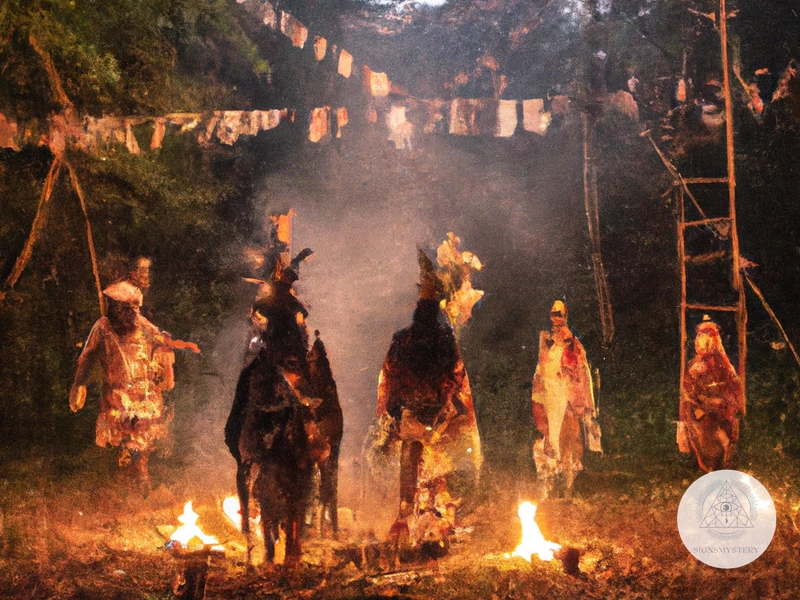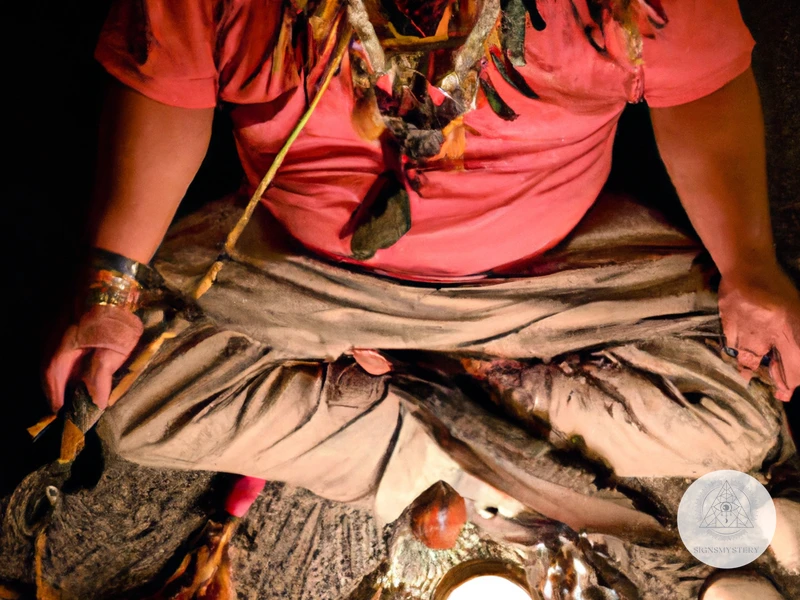As contemporary shamanic practices gain popularity, so do discussions and debates around cultural appropriation. The line between honoring traditions and appropriating them can be blurry, and opinions on the matter vary widely. In this article, we will explore the controversy surrounding cultural appropriation in contemporary shamanic practices. We’ll begin by examining what cultural appropriation is, why it is significant, and how it manifests in modern society. Then, we’ll delve into the historical roots of shamanism and how indigenous practices are used in modern shamanism. We’ll also examine the perspectives of indigenous communities on cultural appropriation and the dangers it poses. Finally, we’ll discuss the debate around cultural appropriation in shamanism, how to approach shamanic practices with respect and sensitivity, and the importance of communication and mutual respect. Let’s begin this complex and thought-provoking journey.
What is Cultural Appropriation?

Cultural appropriation is the adoption of certain elements of one culture by members of a different culture. It is often considered controversial as it can perpetuate stereotypes and exploit marginalized communities. The line between appreciation and appropriation can be blurry, but some examples include wearing Native American headdresses as fashion accessories or using traditional African American hairstyles as a trend without understanding their cultural significance. It is important to understand the harm that cultural appropriation can cause and approach different cultures with sensitivity and respect. For example, in shamanic practices, it is crucial to honor the indigenous roots of these traditions and seek permission from indigenous communities before using their practices.
A Brief Definition
Cultural appropriation is a widely debated issue in today’s society, especially in regards to shamanic practices. It refers to the act of taking elements from a culture that is not one’s own, without showing respect or understanding of its significance. Cultural appropriation can include language, music, dress, food, and spiritual practices. In terms of shamanic practices, cultural appropriation often involves the misuse of traditional indigenous practices by non-indigenous individuals. This can range from using sacred symbols and objects without permission or understanding, to incorporating psychedelics into shamanic practices without proper knowledge or guidance. The issue of cultural appropriation is controversial because it disregards the cultural significance and history of the practices and objects being appropriated. Ultimately, cultural appropriation can lead to the erasure and disrespect of indigenous cultures and their traditions.
Examples in Modern Society
Many cultural appropriation controversies in modern society involve fashion, music, and festivals. For example, the use of Native American headdresses has become a common fashion trend at music festivals. However, the headdresses have significant cultural and spiritual importance in Native American cultures and are reserved for certain leaders or warriors. The practice of non-Native individuals wearing headdresses as fashion accessories not only strips the headdress of its cultural and spiritual significance but also perpetuates harmful stereotypes about Native Americans.
Similarly, the appropriation of Buddhist symbols within popular culture has become a debated topic. The use of Buddha statues as home decor or as a fashion statement can be seen as disrespectful and insensitive to the Buddhist religion. The use of spiritual practices such as yoga, meditation, and mindfulness by Western cultures has been criticized by some as cultural appropriation and an example of how Western societies have commodified and appropriated Eastern spiritual practices.
In the context of shamanism, a controversial practice has arisen where Westerners seek shamanic journeys with the help of psychedelics. Psychedelic-assisted therapy has been shown to be effective in treating certain mental health conditions, and some individuals believe that the use of psychedelic drugs can facilitate shamanic experiences. However, there is an ongoing debate within the shamanic community regarding the use of psychedelics in shamanic practices as some believe that it is disrespectful to the indigenous cultures where shamanism originated.
It is important to note that the examples mentioned above are not exhaustive, and the issue of cultural appropriation is complex. While some argue that cultural exchange and sharing is positive, others believe it is important to approach cultural practice with respect and sensitivity to the significance of the cultural practices to their origins. The topic of cultural appropriation is further explored within the context of shamanism in the following sections.
Why it Matters
Cultural appropriation is a highly contentious issue in modern society. It matters because it is the exploitative adoption or use of the cultural practices and artifacts of one community by members of another community, often for commercial gain or personal benefit. This kind of exploitation can result in the distortion and erasure of a culture’s history, beliefs, and traditions.
When it comes to shamanism, cultural appropriation can have particularly damaging consequences, as shamanic practices have been an integral part of indigenous cultures for thousands of years. These practices hold significant spiritual, cultural, and historical meaning for indigenous communities, and their misuse can have far-reaching negative impacts.
Not only does cultural appropriation in shamanic practices perpetuate stereotypes of indigenous cultures, it can also lead to further marginalization and exploitation of indigenous communities. Additionally, it can damage the authenticity and effectiveness of shamanic practices.
It is vital to recognize the historical context of cultural appropriation in shamanism. Colonization, forced assimilation, and other forms of cultural erasure have already caused significant harm to indigenous communities. Appropriating their cultural practices and beliefs makes it difficult for them to reclaim and preserve their cultural traditions.
It is crucial, then, for individuals interested in shamanic practices to approach these practices with respect, understanding, and sensitivity. This includes understanding the historical and cultural context of the practices, seeking permission and building relationships with indigenous communities, and avoiding stereotypes and misrepresentations. By doing so, it is possible to honor and preserve the authenticity and cultural integrity of shamanic practices while also respecting the people and communities from which they originate.
Shamanism and Cultural Appropriation
Shamanism is an ancient practice that has been passed down through indigenous cultures for centuries. It involves the use of rituals, ceremonies, and healing techniques to connect with the spiritual world and provide guidance and healing to individuals. However, in contemporary society, there has been a growing trend of cultural appropriation where non-indigenous individuals are adopting shamanic practices without fully understanding or respecting their cultural roots. This can be harmful as it dilutes the authenticity of the practice and disrespects the indigenous communities who have preserved it for generations. It is important for individuals who are interested in shamanic practices to educate themselves about its origins and to approach it with respect and sensitivity.
The Historical Roots of Shamanism
Shamanism has its roots in the ancient animistic traditions of various indigenous cultures across the world. The term “shaman” comes from the Tungus tribe in Siberia, where it was used to refer to a person who could enter a trance and communicate with the spirit world. However, similar practices can be found in cultures from South America to Africa to Asia.
Shamanic traditions were often focused on healing and spiritual guidance, with the shaman acting as an intermediary between the physical and spiritual worlds. This often involved the use of various natural substances, such as plants or mushrooms, to induce altered states of consciousness.
Many indigenous cultures see shamanic practices as an important part of their spiritual and cultural heritage. However, the historical use of shamanic practices has been marred by colonization, forced assimilation, and cultural appropriation.
It’s important to understand and honor the cultural and historical context of shamanic practices, rather than treating them as a commodity or trend. For example, the use of psychedelics in shamanic journeys has become popularized in recent years, but it’s important to recognize that their use in indigenous cultures is steeped in specific rituals and traditions.
In understanding the historical roots of shamanism, we can better appreciate its significance and approach it with respect and sensitivity.
The Use of Indigenous Practices in Modern Shamanism
Many modern practitioners of shamanism incorporate indigenous practices into their work. This includes the use of traditional techniques such as drumming, chanting, and plant medicine ceremonies like Ayahuasca and Peyote. However, this has led to a growing concern over the appropriation of these practices by non-indigenous individuals.
While some argue that incorporating these practices helps to keep them alive and spread their benefits to a wider audience, others believe that it is disrespectful and harmful to take practices out of their cultural context without proper knowledge, understanding, and respect for the traditions from which they originated.
The issue also arises in the commercialization of shamanic practices and ceremonies by non-indigenous individuals who are charging money for their services. Some believe that this further perpetuates the exploitation of indigenous cultures for profit and takes away from the traditional communal and spiritual roots of shamanism.
It’s important to note that there is no one unified view on the issue among indigenous groups – reactions range from acceptance and support for non-indigenous practitioners, to condemnation and anger at those who appropriate their cultural practices for their own benefit.
As shamanism becomes increasingly popular and mainstream, it’s crucial for practitioners to educate themselves on the history and cultural context of the practices they engage with, and to approach them with respect and sensitivity. This means being vigilant about cultural appropriation and seeking permission and guidance from indigenous communities whenever possible.
Internal link: Psychedelics and Shamanic Journeys: An Exploration
The Perspectives of Indigenous Communities
Indigenous communities around the world have consistently voiced their perspectives on cultural appropriation in shamanism. Many indigenous people view contemporary shamanic practices that borrow from their cultures as problematic and disrespectful.
It is important to understand that shamanism is not just a set of practices, but a way of life and a deeply spiritual tradition for indigenous communities. Many view appropriation of shamanic practices as a form of spiritual theft that disrespects their cultures and beliefs.
Indigenous peoples have also expressed concerns about the potential harm that can result from improperly conducted shamanic practices. Practices that are not rooted in a deep understanding of the cultural context and spiritual significance of shamanism can cause harm both to the practitioner and the community.
Many indigenous communities emphasize the importance of reciprocity and respectful relationships. They believe that those who wish to practice shamanism should approach it with the reverence and respect it deserves. This includes seeking permission from the indigenous communities and building relationships based on mutual respect and understanding.
Indigenous peoples call for more education on traditional shamanic practices and cultural values. By sharing their knowledge, they hope to prevent cultural appropriation and promote a more sensitive and respectful approach to shamanism.
It is essential to acknowledge and respect the perspectives of indigenous communities when it comes to shamanism and cultural appropriation. Without proper understanding and respect, contemporary shamanic practices can cause harm and disrespect to the cultures and traditions from which they are derived.
The Dangers of Cultural Appropriation in Shamanism
can be profound and significant for several reasons. One of the most notable concerns is that by engaging in cultural appropriation, a person or group may be contributing to the oppression and erasure of Indigenous cultures and communities. Shamanism is often deeply intertwined with the spiritual and cultural traditions of Indigenous peoples, and by co-opting these practices, individuals may be perpetuating harmful stereotypes and misunderstandings about these communities.
Another danger of cultural appropriation in shamanism is that it can lead to a dilution or distortion of the original practices. When individuals with little knowledge or respect for the cultural context in which shamanic practices developed use and adapt these practices, they risk losing their cultural authenticity and significance. This can lead to a rise of ‘plastic’ shamans, who exploit Indigenous spiritual practices for personal or commercial gain and misrepresent the deeper traditions and values of shamanism.
Without a deep understanding and appreciation for the cultural context of shamanic practices, individuals who engage in cultural appropriation may be at risk of harm or injury. Some shamanic practices involve physical or mental challenges that should only be undertaken with the guidance and support of a trained practitioner. Without this expert guidance, individuals may be putting themselves in danger and risking negative spiritual or psychological outcomes.
Finally, individuals who engage in cultural appropriation and colonialism in shamanism may be doing harm to their own spiritual growth and healing journey. Shamanic practices must be approached with respect and humility, and by disregarding the cultural context in which these practices developed, individuals may be undermining their own ability to access the transformative power of these healing modalities.
It is vital to acknowledge and navigate the dangers of cultural appropriation and colonialism in shamanism if we want to ensure the continued vitality, authenticity, and integrity of these practices. By engaging in respectful and collaborative relationships with Indigenous communities, seeking guidance and training from authentic practitioners, and approaching shamanic practices with humility and respect, we can ensure that we honor and uphold the powerful traditions of shamanism for generations to come.
The Debate Around Cultural Appropriation in Shamanism

The debate surrounding cultural appropriation in shamanism is a complex and contentious issue. On one hand, advocates for cultural appropriation argue that shamanic practices have always evolved and adapted as they spread to different cultures. Supporters believe that everyone should have access to shamanic practices and that cultural boundaries should not limit spiritual exploration. On the other hand, opponents believe that cultural appropriation is a form of exploitation that robs indigenous communities of their traditions and livelihoods. They argue that shamanic practices are deeply rooted in cultural and historical contexts and should be honored and practiced only by those with a legitimate connection to those cultures. Ultimately, the key to resolving this debate is open and respectful communication, seeking permission, and building relationships with indigenous communities while honoring and preserving their cultural heritage. And there are many ways to approach shamanism with respect such as learning, honoring and avoiding stereotypes about indigenous culture, and being open to criticism and feedback.
Arguments Against Cultural Appropriation
Opponents of cultural appropriation in shamanism argue that it is ethically wrong to borrow sacred practices without understanding the cultural significance behind them. They believe that shamanic practices are deeply rooted in indigenous traditions and that their misuse can lead to cultural exploitation and erasure.
Cultural appropriation in shamanism can lead to the homogenization of spiritual practices, which can dilute their cultural significance. Many argue that it is disrespectful to appropriate these traditions in a way that ignores the historical traumas and ongoing struggles faced by indigenous communities.
Critics also suggest that non-indigenous shamanic practitioners often charge high fees for their services, which can be seen as a form of economic exploitation. As indigenous communities continue to grapple with economic inequality and poverty, they might not have the same opportunities to profit from these practices.
Ultimately, those against cultural appropriation in shamanism argue that respect for cultural diversity and the histories and traditions of indigenous peoples should be a top priority. It is important for non-indigenous practitioners to recognize their own privilege and to approach these practices with respect, sensitivity, and humility.
Arguments For Cultural Appropriation
While there are strong arguments against cultural appropriation in contemporary shamanic practices, some individuals and communities use the practice in a way that they argue is respectful and beneficial. Here are some of the main arguments in favor of cultural appropriation in this context:
| Argument | Description |
| 1. Evolution of practices | Some argue that cultural appropriation allows practices to evolve and change in response to modern societal needs. They believe that borrowing from different cultures can help to create new, more effective techniques. |
| 2. Universal access | Proponents of cultural appropriation argue that it helps to make shamanic practices more accessible to people around the world. They believe that by incorporating different cultural elements, shamanic practices can reach a wider audience. |
| 3. Human connection | Some argue that cultural appropriation in shamanism can help to connect people from different backgrounds and foster understanding and respect between cultures. |
| 4. Individual choice | Those in favor of cultural appropriation say that everyone has the right to choose the practices and beliefs that resonate with them, regardless of their cultural background. |
It’s important to note, however, that these arguments are not without their criticisms. Those who are against cultural appropriation may argue that these benefits can be achieved in a more respectful and ethical way that does not involve appropriating from other cultures. This is a complex and controversial issue with valid arguments on both sides, emphasizing the importance of respectful and considerate cultural exchange in shamanic practices.
The Importance of Communication and Respect
The controversy surrounding cultural appropriation in contemporary shamanic practices is a hotly debated issue. While some argue that the inclusion of indigenous practices in modern shamanism is a form of respect and appreciation, others assert that this type of cultural appropriation is harmful and disrespectful to indigenous communities.
One key factor in determining respectful engagement with indigenous shamanic practices is communication and respect. It is important to understand and acknowledge the historical roots of shamanism while also recognizing the complexities surrounding cultural appropriation. Here are some ways to approach shamanic practices with communication and respect:
| Approach | Explanation |
|---|---|
| Engage in Dialogue | Seek out and engage in honest, respectful dialogue with indigenous communities to learn about their traditions and perspectives. This can help build relationships and create a mutually beneficial exchange. |
| Acknowledge the Roots | Learn about the historical roots of shamanism and appreciate the indigenous cultures from which it originated. This includes understanding the role of shamanism in these cultures and respecting their spiritual beliefs and practices. |
| Avoid Appropriation | Be mindful of appropriating indigenous practicesSubscribe to Our NewsletterSign up to receive the latest news and updates. |
| Be Open to Criticism | Be open to feedback and corrective criticism from indigenous communities and individuals. This includes accepting and making efforts to learn from constructive criticism and adjusting practices as needed. |
By approaching shamanic practices with communication and respect, individuals and communities can work towards engaging with indigenous traditions in a respectful and meaningful way. It is important to recognize that this process involves ongoing learning and growth, and a commitment to understanding and rectifying mistakes as they arise.
For those who are interested in further exploration of the ethical considerations of contemporary shamanism, The Ethics of Charging for Shamanic Services is a great resource. Additionally, Healing Trauma with Shamanism and Shamanism, Psychology, and Modern Therapy can provide further insight into the potential benefits and risks of engaging with shamanic practices. For those new to contemporary shamanism, our Contemporary Shamanism Basics Guide is a great starting point for further exploration and learning.
How to Approach Shamanic Practices with Respect and Sensitivity
When approaching shamanic practices with respect and sensitivity, it’s important to prioritize learning and honoring the indigenous roots of shamanism. Take the time to research the specific culture and practices you want to incorporate into your own practice. Seek out resources from indigenous communities and individuals, and attend workshops or ceremonies led by indigenous practitioners. Building relationships and seeking permission is also crucial in order to avoid appropriating practices without proper understanding and appreciation. Avoid stereotyping or misrepresenting indigenous cultures, and be open to criticism and feedback in order to continue learning and improving. It’s important to approach shamanic practices with humility and a willingness to learn in a way that is respectful and sensitive to the indigenous communities whose practices you seek to incorporate.
Learning and Honoring the Indigenous Roots of Shamanism
Learning and honoring the indigenous roots of shamanism is crucial to approaching shamanic practices with respect and sensitivity. Here are some steps that can help individuals do just that:
- Study Indigenous History: Taking the time to learn about the indigenous history behind shamanic practices is essential. Read books, watch documentaries, and talk to members of indigenous communities to gain a deeper understanding of the cultural significance of shamanism in their traditions.
- Connect with Indigenous Communities: Building relationships with indigenous communities is another way to honor their roots. Attend cultural events, listen to their stories, and participate in their traditions. This not only shows respect but also helps to build trust with these communities.
- Find a Teacher: Consider finding a teacher who is a member of an indigenous community and has extensive knowledge of shamanic practices. This can provide valuable guidance on how to appropriately approach and honor these traditions.
- Avoid Appropriation: Avoid appropriating indigenous cultures in shamanic practices by avoiding the use of sacred objects and practices from cultures that are not your own. Respect the boundaries set by indigenous communities and do not use their traditions for personal profit or gain.
- Show Appreciation: Express appreciation and gratitude for the knowledge and teachings that indigenous communities share. Show respect for their traditions and always ask for permission before using any of their practices in your own shamanic work.
By taking the time to learn and honor the indigenous roots of shamanism, practitioners can create a space of respect and appreciation for these traditions. It not only shows respect for the cultures in which shamanism originated, but also helps to protect them from appropriation and misrepresentation.
Seeking Permission and Building Relationships with Indigenous Communities
One essential way to approach shamanic practices respectfully and sensitively is by seeking permission and building relationships with Indigenous communities. This involves acknowledging the Indigenous people’s ownership of the practice and showing respect for their culture and traditions. One might begin by researching and understanding the specific Indigenous cultures and practices one wishes to incorporate into their shamanic work.
Before incorporating Indigenous practices into one’s work, it is important to seek permission from the community in question. This can be done through communication and building relationships with Indigenous leaders, shamanic practitioners, or elders. It may involve attending ceremonies, volunteering, or offering assistance to the community in some way.
Building these relationships can take time, effort, and patience on the part of non-Indigenous practitioners. However, these relationships can be incredibly rewarding and can lead to deeper understanding and appreciation of cultural traditions. It can also help non-Indigenous practitioners develop relationships with people who can offer guidance and insight into the practice.
It is important to note that seeking permission and building relationships is not a one-time event. It should be an ongoing process that requires continuous effort and communication. It is also important to recognize that not all Indigenous communities are open to sharing their practices, and one should always respect their decisions.
Seeking permission and building relationships with Indigenous communities plays a crucial role in approaching shamanic practices with respect and sensitivity. Developing these relationships can not only lead to deeper understanding and appreciation of cultural traditions, but also helps to build bridges between different communities.
Avoiding Stereotypes and Misrepresentations of Indigenous Cultures
When practicing shamanic traditions, it is important to avoid perpetuating stereotypes or misrepresentations of indigenous cultures. This can contribute to the marginalization and erasure of these cultures, rather than honoring and preserving them. Here are some steps you can take to avoid falling into this trap:
- Do your research: Take the time to learn about the culture you are drawing from. This includes reading about their history, beliefs, and practices, as well as understanding the context in which those practices developed. Recognize that each culture is unique and diverse, so avoid generalizations and assumptions.
- Avoid commercializing or commodifying sacred practices: Selling items such as smudge kits or feather headdresses can be seen as appropriating sacred indigenous practices for profit. Instead, consider creating your own altar or using items that have personal significance to you.
- Avoid appropriating sacred symbols: Certain symbols, such as the dreamcatcher or medicine wheel, have deep spiritual significance in indigenous cultures. It is important to understand this significance and avoid using these symbols as mere decorations or accessories.
- Avoid appropriating costumes: Dressing up in stereotypical indigenous costumes, such as war bonnets or headdresses, can be seen as disrespectful and insensitive. Instead, wear clothing that you personally find meaningful or relevant to your practice, without imitating the dress of an indigenous person.
- Acknowledge your privilege: Recognize that as someone who is able to practice shamanism, you likely have certain privileges that indigenous communities may not have. This includes access to resources and opportunities, as well as the ability to freely practice your beliefs without fear of cultural suppression or persecution.
By being mindful of how you represent indigenous cultures, you can help preserve and honor their traditions while also integrating shamanic practices into your own life. Remember to approach these practices with humility and openness, always seeking to learn and grow in a respectful way.
Being Open to Criticism and Feedback
Being open to criticism and feedback is essential in ensuring that shamanic practices are approached with the necessary respect and sensitivity. It is important to recognize that there may be gaps in our knowledge and understanding, and accepting constructive criticism can help identify areas where we need to improve.
To be open to criticism and feedback, it is important to approach conversations with humility and a willingness to listen. Follow these tips to ensure that you are being receptive to feedback:
| Tip | Description |
|---|---|
| Listen actively | When someone offers feedback, try to understand their perspective and ask questions if necessary. Don’t become defensive or dismissive. |
| Take responsibility | If the feedback is valid, take ownership of the mistake or misstep. Acknowledge the harm caused and commit to doing better in the future. |
| Don’t center yourself | Remember that the critique is not about you as an individual, but about the harm caused to marginalized communities. Avoid making the conversation about yourself. |
| Reflect on the feedback | Genuinely consider how you can incorporate the feedback into your practice. Reflect on the ways in which the critique can help you become a more sensitive practitioner. |
| Express gratitude | Thank the person for bringing the issue to your attention and for providing feedback. Express gratitude for the opportunity to learn and grow. |
In addition to being open to criticism and feedback, it’s important to actively seek out voices and perspectives from marginalized communities. Consider attending events or workshops hosted by Indigenous practitioners, or reading books and articles written by Indigenous authors. Engage in ongoing education and learning, and don’t hesitate to ask questions when needed.
By prioritizing a willingness to learn, listen, and reflect, we can approach shamanic practices with the respect and sensitivity that they deserve.
Conclusion
The issue of cultural appropriation in contemporary shamanic practices is a complex and controversial one. On the one hand, there are those who argue that all spiritual practices should be available to anyone who wishes to learn and practice them. On the other hand, there are concerns that the appropriation of indigenous shamanic practices by non-indigenous people is a form of cultural theft that can perpetuate the oppression of indigenous communities and perpetuate harmful stereotypes.
At the heart of this debate is the question of how to approach shamanic practices with respect and sensitivity. While there is no one-size-fits-all answer, there are a few key principles that can help guide a thoughtful and respectful approach.
First, it is important to learn about the indigenous roots of shamanism and to honor and respect the traditions and practices of the communities from which they originate. This includes seeking out opportunities to learn from indigenous teachers and elders, and being open to feedback and criticism from these communities.
Second, it is important to seek permission and build relationships with indigenous communities before engaging in any shamanic practices that have their roots in indigenous cultures. This can involve working with local organizations or individuals to gain a deeper understanding of the community’s practices and needs, and to build trust and mutual respect.
Third, it is important to avoid stereotyping or misrepresenting indigenous cultures in any way. This means being aware of the historical and cultural context of the practices you are engaging in, and avoiding appropriating any elements that are sacred or significant to indigenous people.
Finally, it is important to approach shamanic practices with humility and an openness to learning. This means being willing to listen to feedback and criticism from indigenous communities, and being open to changing your approach based on what you learn.
Overall, the issue of cultural appropriation in contemporary shamanic practices is a complex and nuanced one that requires careful consideration and respect. By approaching these practices with sensitivity and an openness to learning, we can ensure that they are practiced in a way that is respectful and beneficial to all communities involved.
Frequently Asked Questions
What is the definition of cultural appropriation?
Cultural appropriation is the unacknowledged or inappropriate adoption of the customs, practices, beliefs, and symbols of a minority or marginalized culture by members of a dominant culture.
What are some examples of cultural appropriation in modern society?
Examples of cultural appropriation include the wearing of headdresses and other sacred items of indigenous cultures as fashion accessories, the use of religious symbols or ceremonies outside of their original context, and adopting the language or music of a culture without acknowledging its source.
Why is cultural appropriation important to discuss in contemporary shamanic practices?
Contemporary shamanic practices often incorporate elements of indigenous cultures, which can lead to cultural appropriation. It is important to engage in a respectful and ethical way with these practices in order to avoid harming indigenous communities and traditions.
What are the historical roots of shamanism?
Shamanism is a traditional practice that has existed in various forms across cultures for millennia. It involves a spiritual connection to the natural world and the use of healing and divinatory practices.
How is the use of indigenous practices in modern shamanism viewed by indigenous communities?
Indigenous communities may be offended by the appropriation of their practices and may feel that they have been disrespected and exploited.
What are the dangers of cultural appropriation in shamanism?
The danger of cultural appropriation in shamanism is the erasure of indigenous traditions and the perpetuation of stereotypes and misrepresentations of indigenous cultures. It can also lead to the commodification of these practices, which can be harmful to indigenous communities.
What are some arguments for cultural appropriation in shamanism?
Some people argue that cultural exchange and borrowing is essential to the evolution of traditions and that shamanic practices should be available to anyone who wants to practice them.
What are some ways to approach shamanic practices with respect and sensitivity?
To approach shamanic practices with respect and sensitivity, it is important to learn about the cultural context and history of the practices, seek permission and build relationships with indigenous communities, avoid stereotypes and misrepresentations of indigenous cultures, and be open to criticism and feedback.
What is the importance of communication and respect in the debate around cultural appropriation in shamanism?
Communication and respect are essential to engaging in a respectful and ethical way with shamanic practices. It is important to listen to the perspectives of indigenous communities and engage in dialogue about the respectful use of shamanic practices.
What is the conclusion of the debate around cultural appropriation in shamanism?
The debate around cultural appropriation in shamanism is ongoing and complex. It is important to approach these practices with respect and sensitivity and to engage in dialogue with indigenous communities about the respectful use of their traditions.










